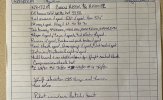Hi. I am looking for information and advice regarding plane purchase. I understand the process in general ( title search per AOPA etc) after we find plane we are interested in. What do we do 1st? Contact seller? Make written offer? Do title search? Set up escrow, do pre-buy? I want to know what the sequence should be. The pre-buy may be a challenge. He is maintaining the plane at Lexington KY Blue Grass and that is the name of mechanic that pops up for pre-buys in that are. I doubt we can get our local Maryland mechanic to travel to KY so it makes sense to find someone local. Thoroughbread cannot do the inspection because they did annual and maintenance. I would prefer someone else without conflict of interest.My understanding that one we make offer we need to do inspection as soon as possible, so I need to identify someone who can do it pretty quickly. Financial will not be an issue. We are looking at little Cessna 150
Lots of ways to do it but here's my checklist:
1a) Figure out your mission, budget and what you're seeking. Doesn't hurt to post on PoA and get others opinions based on your mission - lots of people do it.
1b) Call up an insurance broker/company and see if you qualify for insurance and can afford it. You may find that insurance fires a SAM site missile directly into your dream plane. For instance, I was quoted 12k$ per YEAR on a plane that I thought would be less than half that.
1c) If you're using financing -- get a prequalification so you know what your budget is [A LOT of deals seem to fall apart b/c buyer can't put financing together -- a totally preventable problem]
2) Get a local A&P who you intend to work on your plane going forward. It can be hard to pick one if you have no basis for choosing one over the other. Ask around your local airport for recommendations. If people have gotten burned they may delight in telling you who NOT to use.
3) Find an airplane online: TAP, Controller, Barnstormers are the top ones I think
4) Call the seller. Ask your normal questions (
e.g., damage history/pricing/etc) but also ask for a copy of the logs, at least the most recent ones. Past 3-5y of annuals or so / organized AD compliance sheets if they have them. They should be able to provide a digital copy.
5) Look through the logs and if your cursory glance is good - provide them to your A&P for their opinion. Keep in mind you'll be paying for their time to review the logs even if you don't move forward.
6) If you're interested after getting the A&P's opinion -- set up a time to look at the airplane in person. Or if its far away you might skip this step.
7) Make a written offer SUBJECT TO PREBUY INSPECTION based on the agreed price. Also specify terms that allow you to back out. In your prebuy you spell out what you are and are not allowed to do during inspection.
8) Pay your deposit if required per your agreement. I recommend using an escrow service like Aerospace Reports to protect both your interests. Personally, I would not be willing to PayPal/write a check to a rando. Too many dishonest people out there.
9) See if your mechanic can go out there ($$$$) or find a local mechanic to look at the plane who can coordinate with your mechanic on what specifically to look for.
10) Negotiate based on what you find. Particularly any AD/airworthiness concerns should be negotiated. Don't try to nickel and dime on cosmetic things or items you knew about going into the prebuy.
11) Complete the deal.
While the plane is under the knife getting prebuy, some choose to just continue with the inspection and turn it into an annual. Some refer to this as a prebuy-annual.
Note: Have patience. When I first started shopping I got frustrated that I was paying for a prebuy and the mechanic shot down the first 3 planes I sent logs over for. It felt like I was paying him yet getting no closer to owning. Turns out the best ******** money I ever spent was having a professional tell me "
you don't want this plane, trust me". Best ROI ever.

